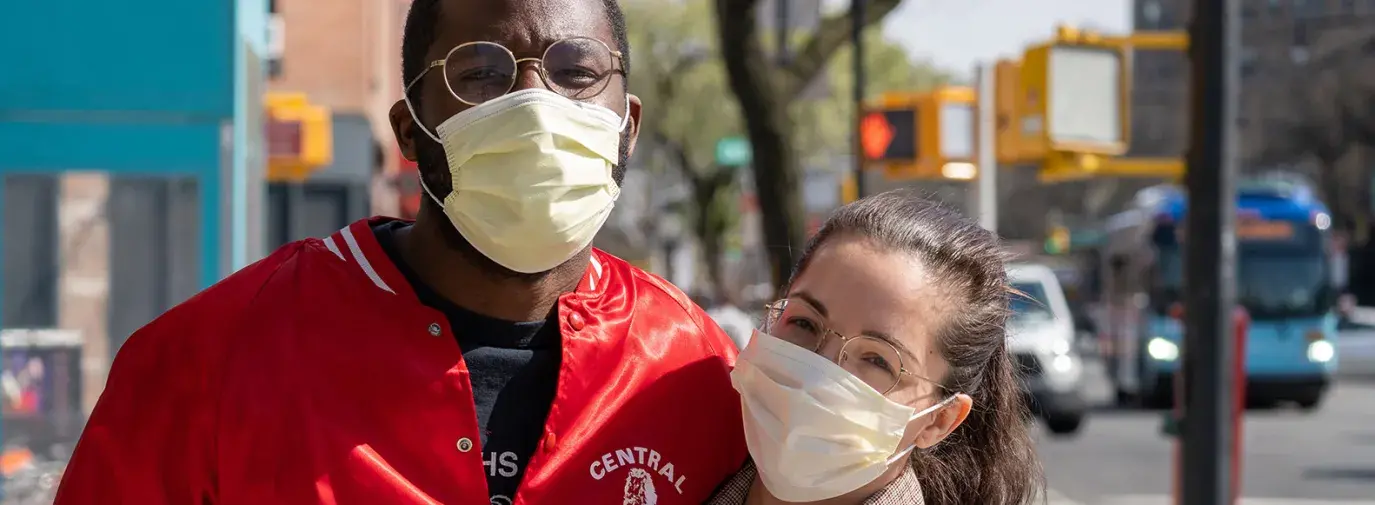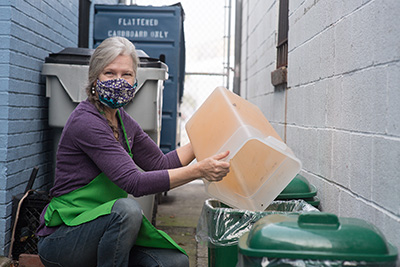
When we envision a fully-fledged climate emergency, scenes of ferocious wildfires, flooded streets, and monstrous weather events like hurricanes and tornadoes commonly come to mind. Writer Mary Annaïse Heglar coined the term “climate vision” to describe this commonly-shared sense of impending doom, and in so many ways, the crises of COVID-19 and climate change are revealing to us the world that we don’t want to see. But through the insights of landmark research and the tenacity of everyday people on the frontlines, both crises are also showing us the world that we want. It is in that spirit of transformative power that we share four lessons to take from the COVID-19 pandemic that can make the climate movement even stronger.
Climate Change is A Public Health Issue
Like the COVID-19 pandemic, overcoming climate change requires both collective behavioral changes on the part of everyday people and bold government policy. One way to move people to action on both fronts is explaining how climate change not only damages the planet’s health, but ours too.
“When we think of policies for solving climate change, it is really important that we put human health at the center. As a society, we don’t talk much about the human toll associated with unmitigated climate change, but it’s projected to get worse if we don’t rise to the challenge,” says Dr. Vijay Limaye, epidemiologist and Natural Resources Defense Council (NRDC) climate and health scientist.
A pioneering model by climate scientist Dr. Jonathan Patz shows how high temperatures, rising sea-levels, and weather extremes can stir the intensity for a variety of illnesses. For example, relentless heat can lead to increased rates of cardiorespiratory failure and unchecked sea-level rises and subsequent floods can provide havens for water-borne diseases like cholera to thrive. In addition, the strain that extreme weather events like wildfires and hurricanes can have on mental health can lead to increased risks of unhealthy coping mechanisms and post-traumatic stress disorder (PTSD).
COVID-19 shows us our current opportunity not only to respond to current challenges but also to invest in preventative healthcare. For example, air pollution is linked to more than 7 million premature deaths worldwide annually, according to the World Health Organization (WHO). Implementing aggressive policies that cut potent greenhouse gas emissions (carbon dioxide, methane) derived from fossil fuels can help stabilize the climate and save lives, especially amid COVID-19, when people with pre-existing conditions are more likely to have fatal outcomes from the virus.
The historic 1970 Clean Air Act is proof of the radical change possible. In the year 2020 alone, the act will prevent an estimated 230,000 premature deaths and since its passage, it has delivered roughly $2 trillion in benefits to the public, according to the Environmental Protection Agency (EPA).
“The Clean Air Act has been a monumental achievement for this country and it can serve as a blueprint for solving climate change,” says Dr. Limaye. “Just as we’re wearing masks and socially distancing, we need to take steps to reduce the underlying burdens of disease, and climate policy plays a huge role in that.”
If It’s Not Just, It’s Not Sustainable
Following the initial outbreak of COVID-19 in the spring, cities like Atlanta, New Orleans, and Washington, D.C.—and others with high populations of people of color and deep financial disparities—emerged as hotspots. Native Americans, African Americans, and Latin Americans all have experienced higher rates compared to white Americans for COVID-19 cases, hospitalizations, and deaths according to the Center for Disease Control and Prevention (CDC). Additionally, some cities with lingering legacies of segregation like Chicago, Detroit, and Milwaukee, report the starkest contrasts of the pandemic’s harm across racial lines. In Milwaukee, for instance, African Americans represent only 27 percent of the population but 51 percent of COVID-19 cases and 57 percent of deaths, according to the Brookings Institute.
“Those disparities don’t just come out of nowhere, they’re the cumulative effect of numerous factors whether it is environmental exposures such as air pollution, reduced quality of care in a hospital, or reduced likelihood of receiving care,” says Limaye. “We’ve also seen high rates of people of color being turned away from facilities because their symptoms were discounted disproportionately.”
The data confirms what leaders in the environmental justice movement have said for decades. Like COVID-19, climate change is slamming communities that have already been marginalized by centuries of systemic oppression, highlighting the urgency for a truly intersectional climate movement.
“It is no accident that the environmental justice movement emerged out of the civil rights movement; it is the same pursuit of equal protection under the law. And it is no coincidence that COVID-19 hotspots are in the same redlined districts mapped out in the 20s and 30s,” says Dr. Robert Bullard, professor of urban planning and environmental policy at Texas Southern University.
In his seminal 1990 book, Dumping in Dixie: Race, Class and Environmental Quality, Bullard led a historic study that revealed that toxic sites like landfills, oil refineries, and chemical plants are largely located near communities of color and communities with lower incomes. Amid this year’s back-to-back news stories of Black men and women being recklessly killed by police and the global protests that followed, many environmental organizations join a chorus of voices that seeks true justice for Black and Brown lives. Bullard, who is also a co-chair of the National Black Environmental Justice Network, says that green groups need to go further by amplifying the call for resources to grassroots, POC-led organizations.
“We have to fight not just on the federal level, but at the local level, in the city councils, county commissions, the school boards, the state legislatures, and the governor’s office and do it 24/7. In order to do that, local groups need to be funded properly,” says Bullard. “White-led environmental groups should make every stride they can to diversify their boards, staff, and agendas, but they must also stand with smaller groups who are calling for green dollars to be diversified, so that resources flow to those on the frontlines.”
A Green Economy Is More Resilient Amid Crises

Amid COVID-19, occasions that would normally draw large crowds have become micro-celebrations and online gatherings. As our lives change, big corporations and small businesses alike have no choice but to keep up with the times. In April 2020, the US unemployment rate soared to a historic 14.7 percent and while those numbers have leveled off, many Americans are still trying to bounce back from job loss while struggling to pay for regular expenses.
Green businesses are being affected by the pandemic too, but many are proving that we do not have to choose between prosperity and sustainability or “growth vs. green.” In fact, eco-friendly and fair labor practices build inherent sustainability and resiliency into a business, and if more companies adopted them, we would see better outcomes for consumers, workers, and families.
Green Plate Catering{GBN} is one of many small businesses that has made a major pivot through the pandemic by switching to a delivery meal business. Owner Kit Wood says people are not catering events much anymore, but she is now able to serve those struggling with food insecurity and seniors by partnering with the Montgomery County Food Council, a community organization advocating for a local and sustainable food system in Montgomery County, Maryland.
“For food businesses, there are always weather disruptions that can make sourcing difficult, but since we work with local farmers and that have more sustainable practices than conglomerates, we can get what we need and mix up the menu when necessary,” says Wood.
Wood is continuing to cut waste by offering biodegradable bamboo packaging. These type of direct climate actions serve as examples to restaurants and big corporations who reach more people and can have an even greater impact.
From Lessons Learned to Taking Action
Research by cognitive scientists Hugo Mercier and Dan Sperber shows that the way to move people to action isn’t through facts alone but emotion. We can create change from the bottom-up by realizing the power our words, stories, and actions have to inspire others. Take these actions for a stronger, more just, and healthy world.
Push Politicians Further
The people in Congress, the White House, and courts across the country are meant to represent the people who elect them. Tell the public officials who represent you at the local level and in Congress to become champions for strong environmental health and environmental justice legislation including the Environmental Justice for All Act, Health Equity and Accountability Act, and BREATHE Act today. At usa.gov/elected-officials, you can find (and save) your Representative’s contact information.
Get Involved in Local Organizations
When we understand the scale of an issue, it’s only natural to become overwhelmed. But we can overcome those feelings by dealing with what’s in front of us. Plug into a grassroots organization near you that is addressing the issues you care about most. Facebook and Google are great places to start your search.
Be an Ambassador for Small and Green Businesses
Brand ambassadorships are a necessity for internet-savvy companies, but you don’t need a large following to be influential. Supporting neighborhood stores with purchases, online shout-outs, and spreading the word to family and friends can go a long way in helping businesses sustain through COVID-19 and beyond. Visit GreenPages.org to find certified green businesses who offer a wide selection of products.







